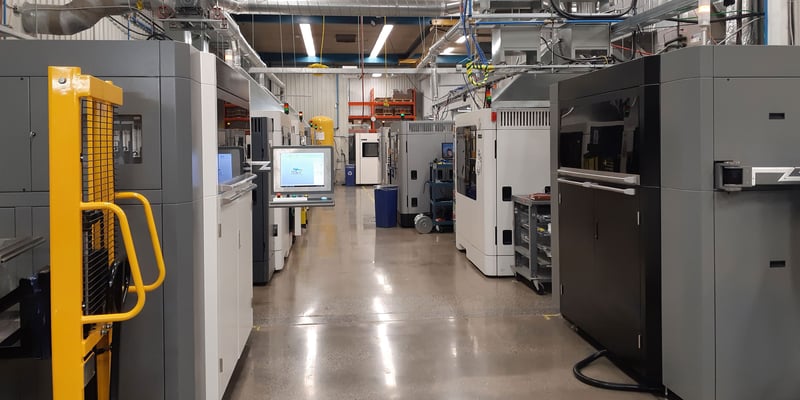SLS 3D Printing: Applications in Different Industries
-
By
Marie-Christine Flibotte
February 20 2023
-
Tech tips and tutorials

Solaxis provides high-resolution SLS 3D printing (selective laser sintering) equipment. SLS 3D printing makes it possible to meet a variety of engineering needs, whether it's the search for a specific material, physical, mechanical and functional characteristics, proof of concept, rapid prototyping, or the production of low and intermediate volume series. Here are some concrete examples of projects where it can be valuable to use SLS technology.
Applications of SLS 3D Printing in the Electronics Industry
The "open-type" laser sintering 3D printing equipment allows a certain flexibility in the choice of thermoplastic materials. Applications in the electronics sector are diverse, from validating a proof of concept to printing series of 500 to 600 parts.
For example, polyamide nylon 11 ESD-safe (PA11 ESD), with its excellent antistatic properties for this industry, is used for the production of different casings and covers for sensitive electronic components.
The antistatic properties of PA11 ESD are also beneficial for manufacturing tools designed for handling electronic parts (e.g., resistors, diodes, etc.).
Applications of SLS 3D Printing in the Healthcare and Medical Equipment Industry
The characteristics of the materials are also of paramount importance in the health sector, where issues of biocompatibility and cytotoxicity must sometimes be considered. In this context and thanks to the flexibility offered by the SLS 3D printing technology at Solaxis, the team produces parts in polyamide nylon 11 (PA 11) or polypropylene (PP), according to customer requirements, such as:
- personalized orthotics
- medical casings
- various components for medical equipment
- etc.
In addition to biocompatibility issues, PA 11 or PP are also selected for their high mechanical properties, which provide medical products with optimal performance.
The surface finish of the parts is also important in the health sector, for example to obtain orthotics or other medical components requiring a smooth type finish or even “washable” and “sealed”. To this end, Solaxis has post-treatment equipment to achieve these different requirements, such as the automated and environmentally safe forced steam sealing process.
Applications of SLS 3D Printing in the Ground Transportation Industry
Manufacturing auto parts and specialty vehicles can present several challenges, such as:
- geometric requirements (design, dimension)
- desired mechanical properties (strength, durability)
- resistance to high temperatures
- chemical resistance (ex. to oil and petrol)
- etc.
For small or medium quantities (prototyping phase or pre-production), SLS proves advantageous. The combination of SLS technology, specific materials such as polypropylene (PP), nylon 11 (PA11), nylon 11 carbon-filled (PA11 CF), polyamide nylon 11 ESD (PA11 ESD) and post-processing operations available at Solaxis addresses these varied needs.
For instance, SLS 3D printing is well-suited for the transportation sector to produce the following parts:
- interior trim and bodywork
- various interior parts
- engine components
- tanks and other systems
- jigs and manufacturing aids
Applications of SLS 3D Printing in the Defence and Security Industry
Teams working in the defence and security sector use various printed prototypes of high value for large-scale presentations and specialized events (for example military equipment parts, vehicle components).
In fact, it is easier to make a sales pitch and especially to conclude it when these professionals have a product at hand to present to their potential customers. They can actually manipulate it and thus judge its tactile and functional aspects.
In the defence and security sector, SLS 3D printing can also be used for the production of:
- interior and exterior components for military vehicles
- protective accessories and exoskeleton
- complex parts for drone
- various tools: assembly fixtures, thermoforming molds, cutting jigs, etc.
To meet manufacturers' demand from the defence and security sector, some projects are sensitive and require specific accreditation. This is why Solaxis uses its expertise, including through the Controlled Goods Program and NIST 800–171 for cybersecurity according to CMMC – Cybersecurity Maturity Model Certification.
Applications of SLS 3D Printing in the Aerospace Industry
SLS additive manufacturing represents a major opportunity for the aerospace sector. This technology addresses various challenges, such as:
- optimal solution for small parts in low-volume series
- design flexibility
- lighter aerospace components
- reduced number of parts/part consolidation (simplified assembly process)
Application types can then include various interior parts such as ducts, casings, supports, fasteners, clamps, and frames.
Solaxis is exploring the possibility of integrating certified SLS materials for aircraft parts, such as in its FDM line, where they are commonly used in this industry. Combining SLS additive manufacturing with high-performance thermoplastics certified for aerospace will offer a complementary solution to FDM, providing an advantageous option for low-volume series of small, complex parts for aircraft interiors.
Applications of SLS 3D Printing in Industrial Production
SLS additive manufacturing provides high precision in details and makes it possible to manufacture parts with small wall thicknesses, without significantly affecting their mechanical properties (strength, durability). These are competitive advantages for industrial applications.
Here are a few examples of projects:
- Low-volume series of components for production equipment
- Customized components for lockout, and health and safety parts
- Propellers
- Safety guards
- Clips, supports and fasteners
- Modular assembly systems
- Jigs and fixtures
- Specialized tooling
- Robotic end-of-arm tooling
- Etc.
Opting for SLS 3D printing opens the door to a variety of applications. As a result, this technology finds its place across various sectors such as electronics, healthcare, transportation, defense, and industrial production.
Do you want to validate a concept, design a prototype, or produce parts in low and intermediate volume series? Contact us, it will be our pleasure to help you!


